Themed collection Editors' Collection: Nanomaterials for the environment

Synergetic effect of dual co-catalysts on the activity of BiVO4 for photocatalytic carbamazepine degradation
An efficient visible-light driven three components photocatalyst for carbamazepine (CBZ) degradation has been assembled by co-loading reduction cocatalyst Pt and oxidation cocatalyst Co3O4 (MnOx) on BiVO4. An obvious synergetic effect is observed.
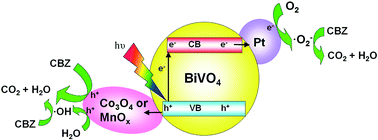
RSC Adv., 2019,9, 41977-41983
https://doi.org/10.1039/C9RA07152K
Highly efficient and rapid removal of arsenic(III) from aqueous solutions by nanoscale zero-valent iron supported on a zirconium 1,4-dicarboxybenzene metal–organic framework (UiO-66 MOF)
A zirconium 1,4-dicarboxybenzene metal–organic framework (UiO-66 MOF) was successfully used as a template to enhance the distribution and activity of nanoscale zero-valent iron (NZVI).
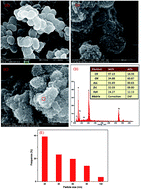
RSC Adv., 2019,9, 39475-39487
https://doi.org/10.1039/C9RA08595E
Improved nanocomposite of montmorillonite and hydroxyapatite for defluoridation of water
A novel hydroxyapatite montmorillonite (HAP-MMT) nanocomposite was synthesized using a simple wet chemical in situ precipitation method. This nanocomposite showed improved adsorption properties towards fluoride ions in water.
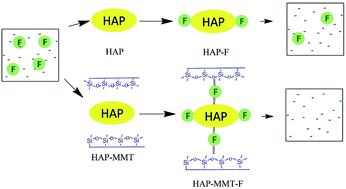
RSC Adv., 2019,9, 35588-35598
https://doi.org/10.1039/C9RA03981C
Effective removal of Cr(VI) from aqueous solution by biochar supported manganese sulfide
In order to remove hexavalent chromium (Cr(VI)) efficiently and simplify the adsorbent preparation process, we employed a single step method to prepare a new biochar supported manganese sulfide material.

RSC Adv., 2019,9, 31333-31342
https://doi.org/10.1039/C9RA06028F
Facile synthesis of novel 3D flower-like magnetic La@Fe/C composites from ilmenite for efficient phosphate removal from aqueous solution
In this study, a novel 3D flower-like La@Fe/C magnetic composite was successfully synthesized by carbothermal reduction of ilmenite via microwave radiation.

RSC Adv., 2019,9, 28312-28322
https://doi.org/10.1039/C9RA05606H
Porous carbon material derived from fungal hyphae and its application for the removal of dye
A highly porous carbon material based on fungal hyphae was prepared using mixed alkali and its application for removal of dye investigated.

RSC Adv., 2019,9, 25480-25487
https://doi.org/10.1039/C9RA04648H
Single-step synthesis of eucalyptus sawdust magnetic activated carbon and its adsorption behavior for methylene blue
Eucalyptus wood-based magnetic activated carbon (MAC) was prepared by single-step carbonization activation magnetization with FeCl3 and utilized for the adsorption of methylene blue (MB).
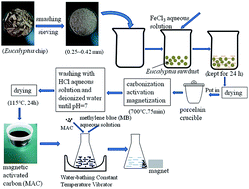
RSC Adv., 2019,9, 22248-22262
https://doi.org/10.1039/C9RA03490K
Systematic study of TiO2/ZnO mixed metal oxides for CO2 photoreduction
A novel example using a systematic design of experiments mixture design for developing mixed metal oxide photocatalysts for CO2 photoreduction.

RSC Adv., 2019,9, 21660-21666
https://doi.org/10.1039/C9RA03435H
One-step synthesis of Fe2O3 nano-rod modified reduced graphene oxide composites for effective Cr(VI) removal: removal capability and mechanism
Reduced graphene oxide (rGO) supported Fe2O3 nanorod composites were prepared via a one-step hydrothermal method and further utilized for hexavalent chromium (Cr(VI)) removal from aqueous environments.

RSC Adv., 2019,9, 20582-20592
https://doi.org/10.1039/C9RA01892A
Efficient detoxification of triclosan by a S–Ag/TiO2@g-C3N4 hybrid photocatalyst: process optimization and bio-toxicity assessment
Owing to their persistency and toxicity, development of an effective strategy to eliminate antibiotic residues from the aquatic system has become a major environmental concern.
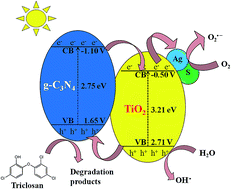
RSC Adv., 2019,9, 20439-20449
https://doi.org/10.1039/C9RA03279G
Green-synthesized copper nanoparticles as a potential antifungal against plant pathogens
The fabrication of fungicides in cost-effective and eco-friendly ways is particularly important for agriculture.

RSC Adv., 2019,9, 18835-18843
https://doi.org/10.1039/C9RA03110C
Effective photoreduction of graphene oxide for photodegradation of volatile organic compounds
Photoreduced graphene oxide has a narrower band gap and better photocatalytic oxidation to degrade methanol.

RSC Adv., 2019,9, 18076-18086
https://doi.org/10.1039/C9RA01209E
Synthesis of mesoporous lanthanum hydroxide with enhanced adsorption performance for phosphate removal
MLHO exhibited outstanding phosphate removal performance with a high adsorption capacity as well as efficient removal in low P concentrations.

RSC Adv., 2019,9, 15257-15264
https://doi.org/10.1039/C9RA00895K
Enhanced catalytic degradation of amoxicillin with TiO2–Fe3O4 composites via a submerged magnetic separation membrane photocatalytic reactor (SMSMPR)
With a TiO2–Fe3O4 composite as the catalyst, amoxicillin was degraded via a photo-Fenton process using a submerged magnetic separation membrane photocatalytic reactor.
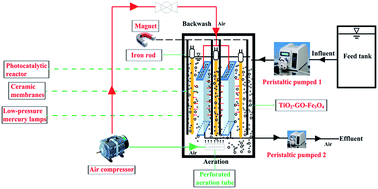
RSC Adv., 2019,9, 12538-12546
https://doi.org/10.1039/C9RA00158A
Enhanced phosphate sequestration by Fe(III) modified biochar derived from coconut shell
In this work, a novel Fe-modified coconut shell biochar (Fe-CSB) was synthesized and utilized to remove phosphate from aqueous solution.
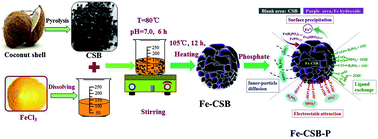
RSC Adv., 2019,9, 10425-10436
https://doi.org/10.1039/C8RA10400J
ZnO decorated Sn3O4 nanosheet nano-heterostructure: a stable photocatalyst for water splitting and dye degradation under natural sunlight
Herein, a facile hydrothermally-assisted sonochemical approach for the synthesis of a ZnO decorated Sn3O4 nano-heterostructure is reported.
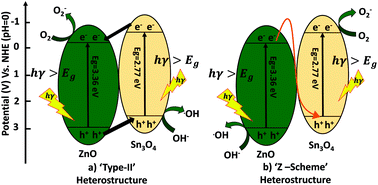
RSC Adv., 2019,9, 10289-10296
https://doi.org/10.1039/C9RA00788A
Retracted Article: Nanocomposite functionalized membranes based on silica nanoparticles cross-linked to electrospun nanofibrous support for arsenic(V) adsorption from contaminated underground water
Development of nanocomposite functionalized membranes for the removal of As(V) from contaminated water.
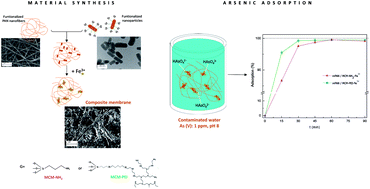
RSC Adv., 2019,9, 8280-8289
https://doi.org/10.1039/C8RA09866B
Multi-shelled ZnO decorated with nitrogen and phosphorus co-doped carbon quantum dots: synthesis and enhanced photodegradation activity of methylene blue in aqueous solutions
The presence of organic dyes in wastewater has posed a huge threat to aquatic life and human health.
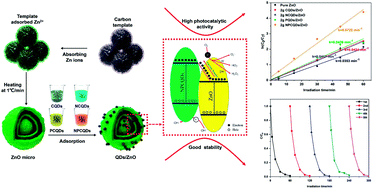
RSC Adv., 2019,9, 7362-7374
https://doi.org/10.1039/C9RA00168A
Preparation of CaMgAl-LDHs and mesoporous silica sorbents derived from blast furnace slag for CO2 capture
A total solution for the utilisation of BFS can be achieved and the resulting valuable products CaMgAl-LDHs and MCM-41 are promising sorbents for CO2 capture.

RSC Adv., 2019,9, 6054-6063
https://doi.org/10.1039/C8RA08458K
Simultaneous capture of methyl orange and chromium(VI) from complex wastewater using polyethylenimine cation decorated magnetic carbon nanotubes as a recyclable adsorbent
An MWCNTs@Fe3O4/PEI composite was facilely fabricated as a robust adsorbent for simultaneously capturing methyl orange (MO) and Cr(VI) from complex wastewater.

RSC Adv., 2019,9, 4722-4734
https://doi.org/10.1039/C8RA08760A
Solar-light-active mesoporous Cr–TiO2 for photodegradation of spent wash: an in-depth study using QTOF LC-MS
A dark coloured effluent called “spent wash” is generated as an unwanted product in sugar based alcohol distillery which is degraded to less toxic compounds using visible light active Cr–TiO2 photocatalyst under natural sunlight.

RSC Adv., 2019,9, 4226-4238
https://doi.org/10.1039/C8RA10026H
Isolated/interacting Au islands on TiO2 NTs for the switching photocatalytic/photoelectrocatalytic degradation of refractory organic pollutants in wastewater
A three-dimensional surface catalyst with isolated/interacting Au islands loaded on TiO2 nanotubes (Au/TiO2 NTs) was prepared for the switching photocatalytic/photoelectrocatalytic (PC/PEC) degradation of refractory organic wastewater, and shows prominent catalytic activity and favorable stability.

RSC Adv., 2019,9, 2784-2791
https://doi.org/10.1039/C8RA09160A
Functionalized biochar-supported magnetic MnFe2O4 nanocomposite for the removal of Pb(II) and Cd(II)
In this study, a novel magnetic biochar-MnFe2O4 nanocomposite (BC/FM) was prepared using low-cost corn straw and MnFe2O4 by sol–gel/pyrolyzing route using egg white, which has abundant functional groups (–NH2 and –COOH).
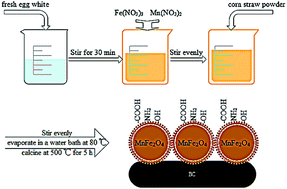
RSC Adv., 2019,9, 365-376
https://doi.org/10.1039/C8RA09061K
About this collection
This collection, guest edited by Associate Editor Ranjit T. Koodali (Western Kentucky University), features articles published in the journal in 2019 on nanomaterials for the environment. Environmental remediation of pollutants have received significant attention due to the issues related to their impact on the health and livelihood of humans. Broadly, removal of pollutants may involve adsorption (transfer from gas/aqueous phase to a solid adsorbent) or their degradation into simple, less complex, and harmless chemicals. Nanomaterials provide enhanced capabilities to remove pollutants because of their relatively high surface areas and small particle sizes.
The examples included in this study include heavy metals such as Pb(II), Cd(II) using biomaterial waste such as corn straw, removal of Fe(III) using coconut shell based materials, use of magnetic nanocomposites to simultaneously remove organics and inorganics, use of nanofibers to remove As(V), removal of fluoride and phosphate ions, fungus, and capture of greenhouse gas such as carbon dioxide. The collection also includes articles that employ photocatalytic and/or photoelectrocatalytic techniques to degrade refractory pollutants such as nitrobenzene, “spent wash” from sugar distilleries, organic dyes, drugs such as amoxicillin, Volatile Organic Compounds (VOC) such as methanol and CO2 photoreduction.
The themed collection reflects the myriad number of innovative approaches developed by researchers to remove pollutants using novel, and often using cost-effective approaches for both the synthesis and subsequent removal of pollutants.